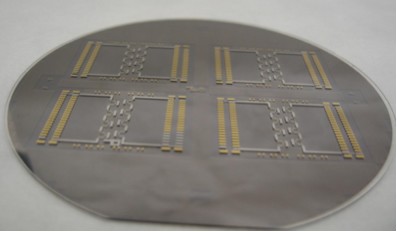Contact:
Frank K. Gürkaynak , PhD, Post-doctoral Reseracher, LSI-IC-LSI
Partners:
Biochemistry Department, University of Bologna, Italy
Electrical Engineering and Computer Science (DEIS), University of Bologna, Italy
Keywords:
Lab-on-Chip, DNA detection, Capacitive Sensors
Presentation:
The technological development in both nanoscale integration of electronic circuits and sensor systems, coupled with a much improved understanding of the biological processes has enabled us to venture to develop so called Labon-Chip (LoC) systems which integrate sensors, actuators and electronics in one system. The most important advantage of these LoC systems will be the speed and cost-efficiency. While such systems will never rival the accuracy of a fully equipped laboratory, it will be possible to have wide-scale deployment and will allow to perform vital analyses practically anywhere on the world.

Photograph of a wafer containing
four capacitive DNA sensors
Such a LoC will rely on a number of specialized sensors for detection. Several research groups have successfully demonstrated that capacitive sensors can be employed to detect whether or not oligonucleotides (short strands of DNA) in a target solution match those functionalized on the surface of gold electrodes. This method is particularly attractive, as it does not require expensive preparation of the samples (label-free) and is simple to implement.
Goal:
In this project, the goal is to develop reliable and cost-efficient methods to manufacture disposable sensors that can be used for DNA detection. We are working towards determining the best geometry for capacitive DNA sensors, cost-effective bio-compatible passivation methods, and efficient realization of high-density connections between the sensor and the processing system. These sensors will be instrumental in developing complete lab-on-chip systems that will allow on-the-field detection of contaminants in food, pollutants in the environment, and pathogens in the human body, without costly laboratory equipment.
Download project description file (1.1 MB pdf)